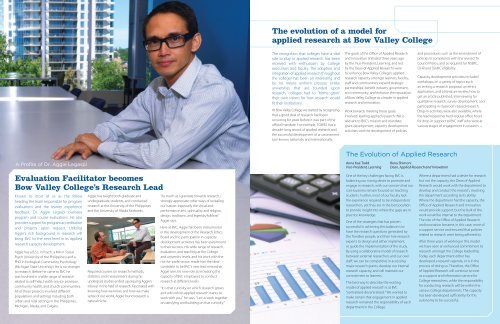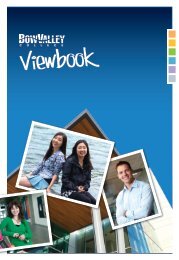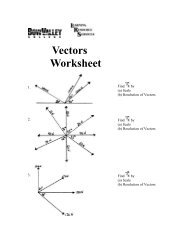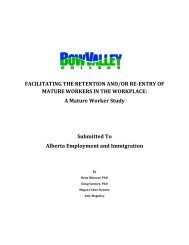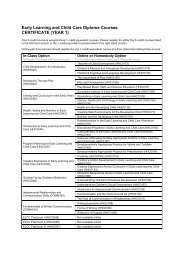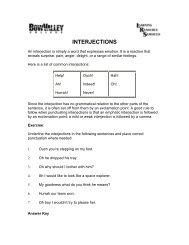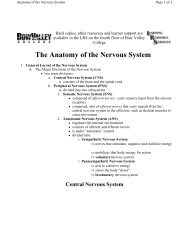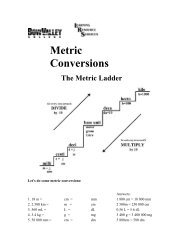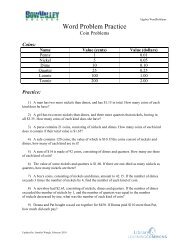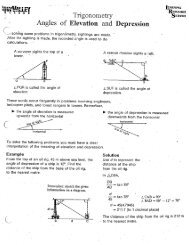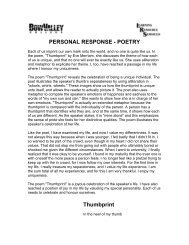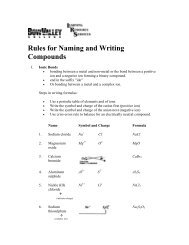Newsletter October 2011 - Bow Valley College
Newsletter October 2011 - Bow Valley College
Newsletter October 2011 - Bow Valley College
Create successful ePaper yourself
Turn your PDF publications into a flip-book with our unique Google optimized e-Paper software.
A Profile of Dr. Aggie Legaspi<br />
Evaluation Facilitator becomes<br />
<strong>Bow</strong> <strong>Valley</strong> <strong>College</strong>’s Research Lead<br />
Known to most of us as the fellow<br />
heading the team responsible for program<br />
evaluations and the learner experience<br />
feedback, Dr. Aggie Legaspi oversees<br />
program and course evaluations. He also<br />
provides support for program accreditation<br />
and projects upon request. Utilizing<br />
Aggie's rich background in research will<br />
bring BVC to the next level in its applied<br />
research capacity development.<br />
Aggie has a B.Sc. in Psych, a MA in Social<br />
Psych (University of the Philippines) and a<br />
PhD in Ecological-Community Psychology<br />
(Michigan State University). He is no stranger<br />
to research. Before he came to BVC he<br />
was involved in a wide range of research<br />
related to self-help, health service provision,<br />
community health, and church communities.<br />
All of these projects involved different<br />
populations and settings including both<br />
urban and rural settings in the Philippines,<br />
Michigan, Alaska, and Calgary.<br />
Aggie has taught both graduate and<br />
undergraduate students, and conducted<br />
research at the University of the Philippines<br />
and the University of Alaska Fairbanks.<br />
Required courses on research methods,<br />
statistics, and measurement during his<br />
undergrad studies ended up piquing Aggie’s<br />
interest in the field of research. Fascinated with<br />
knowing how we know, and how we make<br />
sense of our world, Aggie found research a<br />
natural niche.<br />
“As much as I gravitate towards research, I<br />
strongly appreciate other ways of revealing<br />
our nature–especially the visual and<br />
performance arts, spirituality and religion,<br />
design, traditions, and legends/folklore,”<br />
Aggie says.<br />
Here at BVC, Aggie has been instrumental<br />
in the development of the Research Ethics<br />
Board and his participation in capacity<br />
development activities has been paramount<br />
to their success. His wide range of research,<br />
evaluation, and teaching at the <strong>College</strong><br />
and university levels, and his work with the<br />
not-for-profit sector, made him the ideal<br />
candidate to be BVC’s new lead researcher.<br />
Aggie sees his new role as increasing the<br />
capacity of BVC employees to conduct<br />
research at different levels.<br />
“It is that curiosity on which research grows<br />
and with which applied research wants to<br />
work with you,” he says. “Let us work together<br />
on satisfying and building on that curiosity.”<br />
The evolution of a model for<br />
applied research at <strong>Bow</strong> <strong>Valley</strong> <strong>College</strong><br />
The recognition that colleges have a vital<br />
role to play in applied research has been<br />
received with enthusiasm by <strong>College</strong><br />
executives and faculty. The adoption and<br />
integration of applied research throughout<br />
the colleges has been an interesting and<br />
by no means uniform process. Unlike<br />
universities that are founded upon<br />
research, colleges had to “home grow”<br />
their own visions for how research would<br />
fit their institutions.<br />
At <strong>Bow</strong> <strong>Valley</strong> <strong>College</strong> we started by recognizing<br />
that a good deal of research had been<br />
occurring for years before it was part of the<br />
official mandate. For example, TOWES has a<br />
decade-long record of applied research and<br />
the successful development of an assessment<br />
tool known nationally and internationally.<br />
The goals of the Office of Applied Research<br />
and Innovation (initiated three years ago<br />
by the Vice-President, Learning, and led<br />
by the Dean of Applied Research) were<br />
to: enhance <strong>Bow</strong> <strong>Valley</strong> <strong>College</strong>’s applied<br />
research capacity amongst learners, faculty,<br />
staff and communities; expand strategic<br />
partnerships; benefit industry, government,<br />
and community; and enhance the reputation<br />
of <strong>Bow</strong> <strong>Valley</strong> <strong>College</strong> as a leader in applied<br />
research and innovation.<br />
Work towards meeting these goals<br />
involved: leading applied research that is<br />
relevant to BVC’s mission and mandate;<br />
grant development; capacity development<br />
activities; and the development of policies<br />
and procedures such as the amendment of<br />
policies in compliance with the revised Tri<br />
Council Policy, and as required for NSERC,<br />
CIHR and SSHRC eligibility.<br />
Capacity development activities included<br />
workshops on a variety of topics such<br />
as: writing a research proposal, an ethics<br />
application, and a literature review; how to<br />
get an article published; interviewing for<br />
qualitative research; survey development; and<br />
participating in classroom-based research.<br />
Drop-in activities were also available, where<br />
the lead researcher held regular office hours<br />
for drop-in support to BVC staff who were at<br />
various stages of engagement in research. <br />
The Evolution of Applied Research<br />
Anna Kae Todd Rena Shimoni<br />
Vice-President, Learning Dean, Applied Research and Innovation<br />
One of the key challenges facing BVC is<br />
balancing our strong desire to promote and<br />
engage in research, with our concern that our<br />
core business remain focused on teaching<br />
students. Further, most of our faculty lack<br />
the experience required to be independent<br />
researchers, yet they are in the best position<br />
to provide insight into where the gaps are in<br />
practice knowledge.<br />
One of the strategies that has proven<br />
successful in achieving this balance is to<br />
have the research questions generated by<br />
the frontline people, and then hire research<br />
experts to design and either implement,<br />
or guide the implementation of the study.<br />
By using a collaborative model of research<br />
between external researchers and our own<br />
staff, we can be competitive in accessing<br />
major research grants, develop our internal<br />
research capacity, and still maintain our<br />
commitment to learners.<br />
The best way to describe the existing<br />
model of applied research is at BVC<br />
“centralized-decentralized.” We wanted to<br />
make certain that engagement in applied<br />
research remained the responsibility of each<br />
department in the <strong>College</strong>.<br />
Where a department had a desire for research<br />
but not the capacity, the Dean of Applied<br />
Research would work with the department to<br />
develop and conduct the research, involving<br />
the department according to its ability.<br />
Where the department had the capacity, the<br />
Office of Applied Research and Innovation<br />
would provide support, but the bulk of the<br />
work would be internal to the department.<br />
The role of the Office of Applied Research<br />
and Innovation became, in this case, more of<br />
a support service and ensured that policies<br />
related to research were being adhered to.<br />
After three years of working in this model<br />
we have seen an enhanced commitment to<br />
research amongst the <strong>College</strong> leadership.<br />
Today, each department either has<br />
developed a research agenda, or is in the<br />
process of doing so. Therefore, the Office<br />
of Applied Research will continue to exist<br />
as a support and information service for<br />
<strong>College</strong> researchers, while the responsibility<br />
for conducting research will be within the<br />
various <strong>College</strong> departments. The capacity<br />
has been developed sufficiently for this<br />
autonomy to be successful.


